

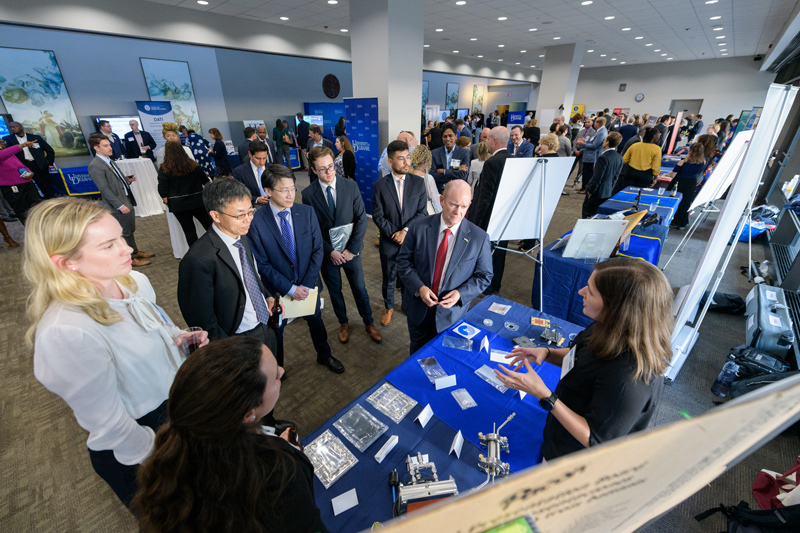
Innovation for the nation
Photos by Evan Krape September 22, 2022
‘UD Day in DC’ shows federal partners the powerful impact of research
WASHINGTON — Just a few hours after the United States Senate ratified a critical environmental treaty with the potential to slow global warming and accelerate manufacturing in the U.S., two Delaware leaders of that effort — Senators Tom Carper and Chris Coons — met with researchers and alumni of the University of Delaware to celebrate the science that makes such progress possible and the Delaware connections that helped make it happen.
The event — UD Day in DC — is designed to demonstrate the impact of federally funded research and is a valuable resource for legislative aides and officers of federal agencies.
“We started this biennial showcase in 2011 because research really is the lifeblood of universities, including the University of Delaware,” said Kelvin Lee, interim vice president for research, scholarship and innovation, in his opening remarks. “It’s vital to our health, it’s vital to our economic wellbeing and it’s vital to society. And the University represents more than $5 billion of economic activity each year throughout the Northeast Corridor.”
With the theme “Innovation for the Nation,” the event included experts in climate change, human health, public policy, agriculture, renewable energy, advanced materials, disabilities studies, space research, sustainability and more.
The gathering was held in the Hart Senate Office Building, just a few blocks from the Capitol, where Carper and Coons had just cast their votes to ratify the 2016 international treaty — known as the Kigali amendment — that would phase out the use of hydrofluorocarbons (HFCs), chemical compounds used in air conditioning and refrigeration that have been identified as powerful accelerants of global warming.
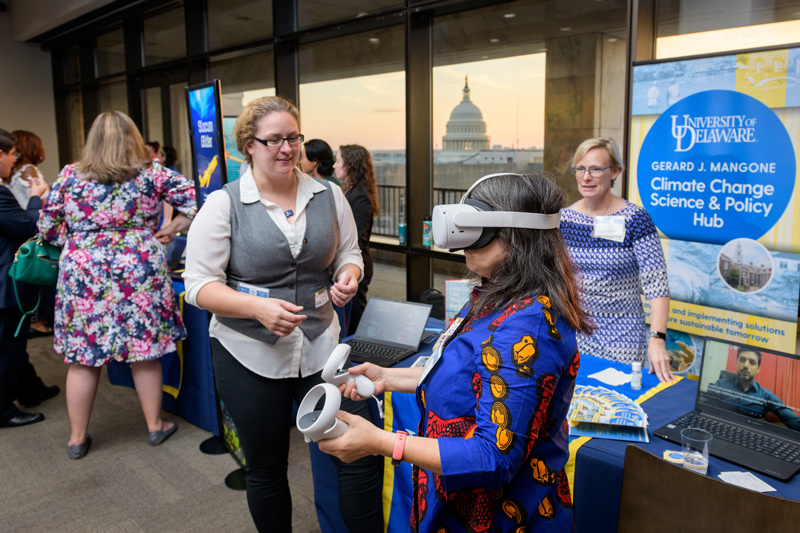
Carper, chair of the Senate’s Environment Committee, said the hydrofluorocarbon phaseout will not only help to slow climate change, but will also be an accelerant for the U.S. economy as alternatives are manufactured.
“We expect tens of thousands of American workers to go to work, with $50 billion of economic activity added to our country,” he said.
Carper joked that though he could barely spell “HFC,” his colleague, Coons, is the only member of the Senate with a degree in chemistry.
Indeed, Coons speaks fluent science and demonstrates respect for the scientific method foundational to all research.
Coons noted that an effective alternative to HFCs — hydrofluoroolefins (HFOs) — were used in a new product invented by Chemours, a Delaware-based DuPont Co. spinoff. HFOs do not have the disastrous global-warming effects of HFCs and they also make air conditioning and refrigeration systems more efficient.
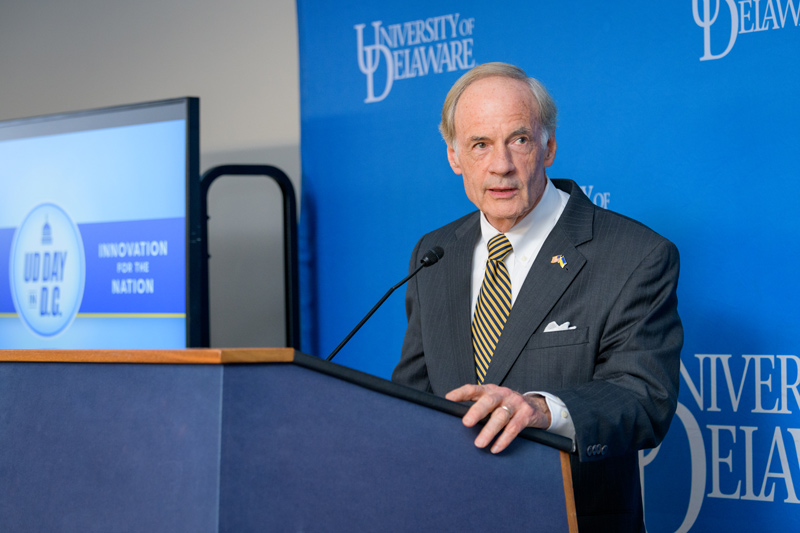
Chemours’ trademarked Opteon is the leading brand of hydrofluoroolefins in the market and Chemours now has a state-of-the-art research center on UD’s Science, Technology and Advanced Research (STAR) Campus, established by UD after Chrysler closed its assembly plant there.
“So today is a great proof point of the ways in which science, public policy and opportunity can all align in a very meaningful way,” Coons said.
Coons, a member of the powerful Senate Appropriations Committee, noted a new $8 million grant awarded by the National Institute of Standards and Technology (NIST) to UD for the National Institute for Innovation in Manufacturing Biopharmaceuticals (NIIMBL), a public-private partnership headquartered at UD. Lee is the founding director of NIIMBL.
“Innovation is truly critical for our nation and in this case a lot of that innovation comes through federal investment, federal programs — and we are really grateful for those federal investments that help improve people’s lives, help strengthen communities and make the economy more robust and resilient,” Lee said.
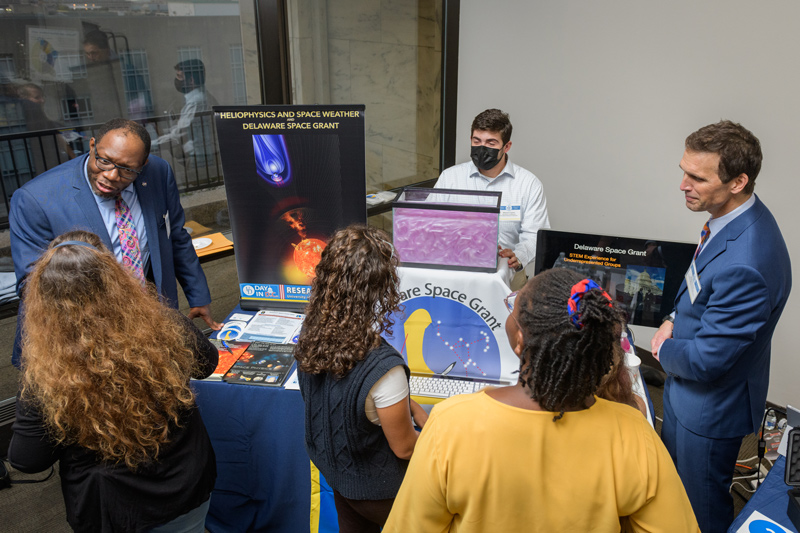
Coons also welcomed Valerie Biden Owens, sister of President Joe Biden and chair of UD’s Biden Institute, to the event. President Biden has emphasized the need for investment in science and research.
“But federal investment would be nothing without you — without your brilliance, your determination, without your optimism, without your belief in the potential of science,” Coons said.
U.S. Rep. Lisa Blunt Rochester was unable to attend. There were several critical votes taking place in the House of Representatives on Wednesday.
But several staffers were on hand, including Victoria Panzera, her Delaware press secretary, and Jannie Kamara, staff assistant.
"This is my first UD Day in D.C.," Kamara said. "The ice cream is to die for. And all of the tables I've gone to have been so informative."
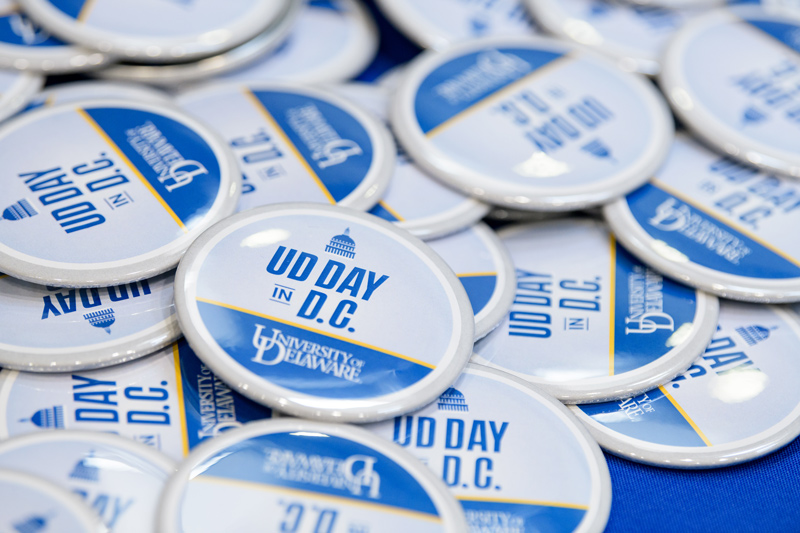
The event was a great experience for many in the room.
“I didn’t focus on the STEM [science, technology, engineering and mathematics] side of things when I was at UD,” said Andrew Garcia, a 2020 UD alum who was an intern in Carper’s office and now is working on Capitol Hill for the Committee on House Administration. “This is a showcase of everything UD has to offer as an R1 research university. Being on the policy side, it’s good to know these things.”
For Dwight Higgin, assistant professor, representing UD’s Associate in Arts Program was a good opportunity to raise awareness of the program and connect with policymakers. Higgin said he hopes to increase student participation in Dover and Georgetown, increase diversity and reach out to students in K-12 to make them aware of opportunities.
“This is going to catapult some of the things I hope to do with AAP,” said Higgin, a UD alum who went on to earn his doctorate in neuroscience.
Don Sparks, internationally renowned expert in environmental science, said he was present to support Delaware’s congressional delegation. He also wanted to meet with a Department of Defense liaison.
“It’s great to do the basic research,” he said. “It’s also important to let people know why it’s important. What problems are we going to solve?”
Sparks brought several doctoral students with him to give them an opportunity to see how science is communicated and the importance of these connections with policymakers.
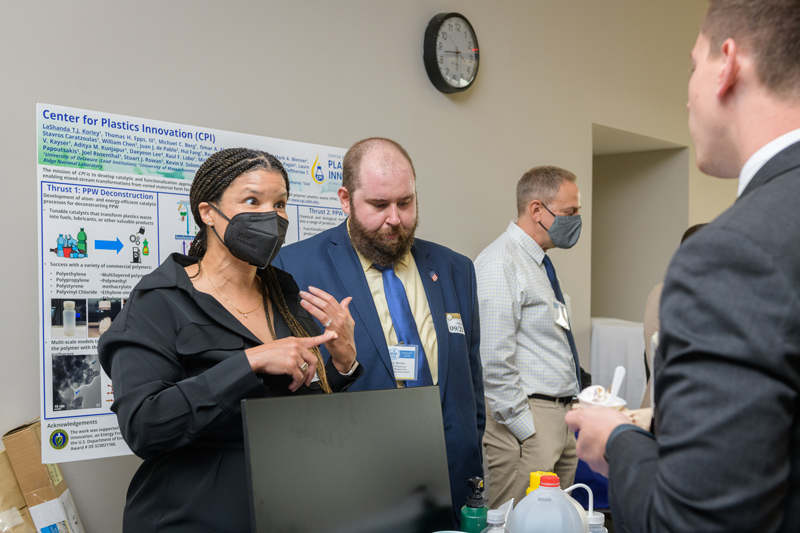
New approaches to that kind of communication were evident.
Collaborators A.R. Siders and Dana Veron offered a virtual reality look at how sea-level rise would affect the community of Bowers Beach. That kind of immersive experience, created by doctoral student Joy McCusker, can help people grasp the perils that come as a consequence of climate change. And it can help them to reconsider their plans.
“You might be considering passing along your property to your children and grandchildren,” Veron said.
Among the dozens of other displays were the extensive research underway at the Center for Plastics Innovation, where researchers are pursuing ways to extend the lifecycle of plastics and produce new and valuable products from what now is plastic waste.
Plastics are complicated by the way products use mixed materials, materials that can’t be reused, materials that are perceived as trash after one use and sent to landfills instead of being recycled.
If the value of the elements used in plastic production is better understood, what now looks only like a huge problem can be an opportunity for innovative new products and solutions. There is reason for such hope, said Distinguished Professor LaShanda Korley, director of CPI.
“The problem is complex,” Korley said. “There are global issues, equity issues, lifestyle issues…. But you can’t just get rid of plastics. They’re useful. And if you consider the feedstocks [materials used in manufacturing], they are valuable.”
It makes much more sense to reclaim that value and reinvest it in new products than to dump it into landfills or into the ocean, where its value becomes a serious environmental liability.
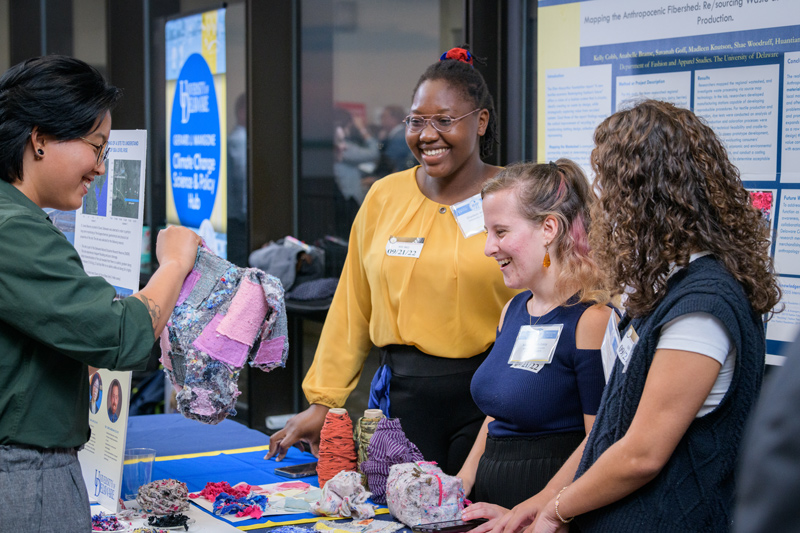
For Yushan Yan, an expert in hydrogen fuel, the event was a great opportunity for a few of his students to see the importance of connecting with policymakers.
“I want them to know that policymakers pay attention to what we do,” he said.
It was impressive to Alex Oliveira, a doctoral student in Yan’s group.
“I don’t get to see this side of what we work on,” she said. “It’s nice to be here to see that people are actually interested.”
Yan said he was interested, too, in the different technologies and research projects underway at UD and saw some collaborative opportunities as he explored the different displays, too.
“I want to sit down and talk to some of them and see what we can do,” he said.
Manuel Cuesta, a graduate research assistant in Prof. Bill Matthaeus’ group in the Department of Physics and Astronomy, stirred up what looked like a big punch bowl, offering an intriguing demonstration of turbulence, the chaotic phenomenon that occurs in space and can create havoc with satellites and communications systems.
Prof. Michael Shay, an expert in heliophysics and that kind of turbulence, was onsite representing Delaware Space Grant and also chatting with a friend and fellow alum of Grinnell College — Tom Kloude — who now works for the Social Security Administration.
That kind of networking can provide solutions for congressional staffers, who may have questions related to the SSA and would benefit from talking with an administrator. Kloude said he told the Delaware congressional delegation he would be onsite if any of their staffers had questions. He said his wife, Troy Cribb, used to work for Carper.
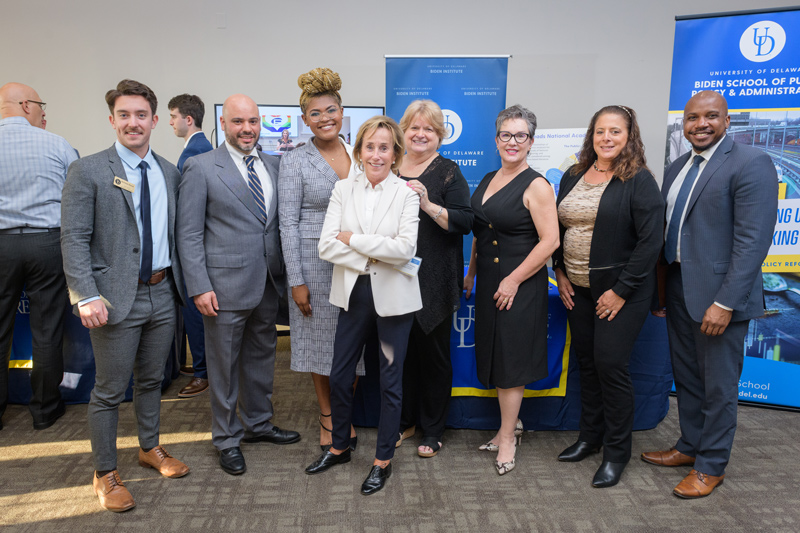
Some of the research on display offered an ironic and important reality check, too.
A collaborative study on the use of scientific information in public decision-making suggests scientific research and data are often missing in the deliberative process when policy is shaped.
Kim Isett, associate dean of research for the Biden School of Public Policy and Administration, is a primary investigator in that three-part study, which looks at the intersection of scientific knowledge, political knowledge and practical, experiential knowledge.
Rather than be discouraged by the low rates of research access, Isett said the study should inform science communication efforts.
“We’ve got to know how to get the science in their hands,” she said. “If we know what those three groups care about, we know how to talk to them.”
Strategies for communicating science can take many forms, of course. The evidence was obvious at a table offering samples of ice cream from the UDairy Creamery.
“We know one simple truth,” Lee said in his opening remarks. “If you lure people with UDairy ice cream you can help them learn important things.”
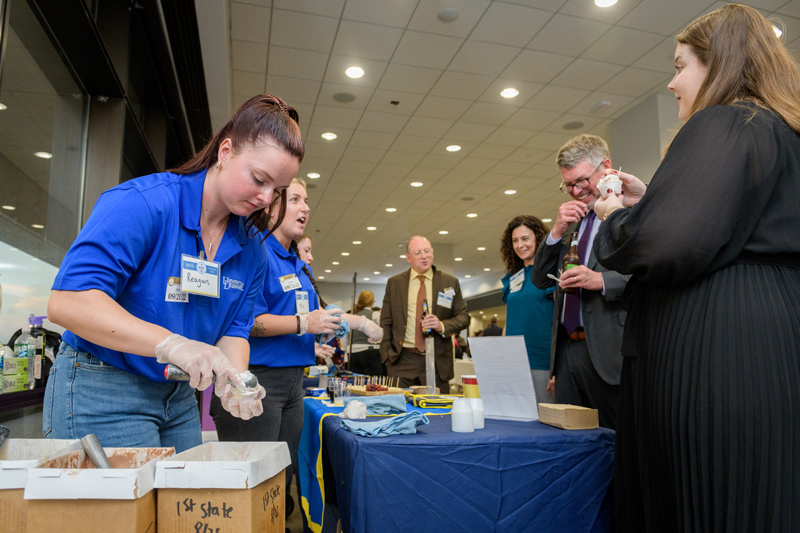
Contact Us
Have a UDaily story idea?
Contact us at ocm@udel.edu
Members of the press
Contact us at 302-831-NEWS or visit the Media Relations website

